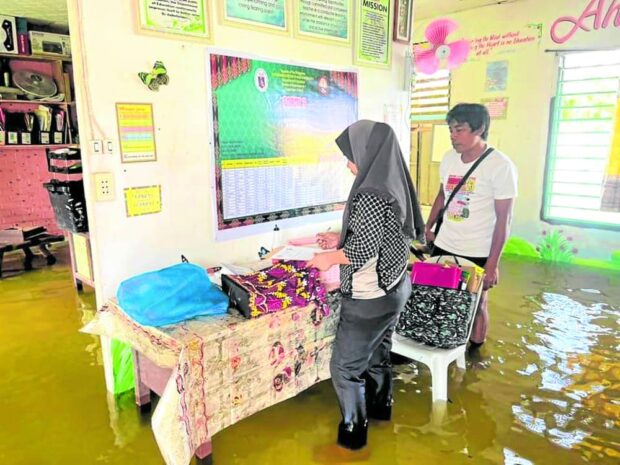
INUNDATED Classes are suspended due to massive flooding in Pagalungan, Maguindanao del Sur, but teachers at the town’s Damalasak Elementary School still report to work on Sept. 18 to collect instruction materials that they can save. —CONTRIBUTED PHOTO
COTABATO CITY—Still coping with the floods and displacement that hit Maguindanao del Sur and Lanao del Sur last week, the Bangsamoro regional government now have to deal with more of its villages getting submerged, this time at its Special Geographic Area (SGA) that used to be part of Cotabato province.
All 63 former Cotabato villages that formed the SGA of the Bangsamoro Autonomous Region in Muslim Mindanao (BARMM) have been placed under a state of calamity due to massive flooding spawned by the Intertropical Convergence Zone (ITCZ) that affected Mindanao the previous week, an official said on Sunday.
The flooding at the SGA came just as the Maguindanao del Sur and Lanao del Sur provinces were still reeling from last week’s floods that displaced some 40,000 residents.
Butch Malang, administrator of the SGA Development Authority (SGADA), said the newly organized Disaster and Risk Reduction and Management Council (DRRMC) in the SGA had passed a resolution that took effect on Sept. 21, placing all 63 barangays under the state of calamity following the flooding that affected 129,730 individuals.
Although only 27 SGA villages were flooded, the total affected households of 25,946, which are made up of 129,730 individuals, represented 60.21 percent of the total SGA population, according to the resolution.
Malang, who chaired the SGA DRRMC, approved the declaration that would last until further notice. BARMM’s humanitarian and emergency response arm, Rapid Emergency Action on Disaster Incidence (READi), attested the declaration.
Damage to crops
Aside from the affected households, a total of 329 hectares of rice, corn and other crops were destroyed by the heavy rainfall in the SGA and other areas in the BARMM, according to READi.
READi’s data showed that the SGA had been flooded four times in 2023, with the past week’s inundation one of the most widespread.
The 63 barangays that compose the SGA formerly belong to towns of Cotabato province. They became part of BARMM’s official territories after they voted to join the Bangsamoro in a plebiscite held on Feb. 6, 2019.
Malang cited Chapter 6, Section 20 (c) of the Bangsamoro Administrative Code (Bangsamoro Autonomy Act No. 13) which authorized the SGADA DRRMC to declare a state of calamity and enforce all laws and regulations for the delivery of basic services and provision of appropriate facilities in the area.
Following the declaration, the prices of basic goods and commodities will be effectively controlled and monitored in the affected areas.
The declaration will also pave the way for the release of funds that will provide the regional government, the SGADA and the Bangsamoro local government units ample latitude in the rescue, response, relief and recovery efforts of those affected by the floods and the basic services to the people.
Maguindanao’s woes
Flash floods also hit the uptown villages of Maguindanao del Sur and Lanao del Sur, affecting some 40,000 individuals.
Ameer Jehad Ambolodto, chief of Maguindanao del Sur’s Provincial Disaster Risk Reduction and Management Office, said sustained rains spawned by the ITCZ on Sept. 18 that continued until dawn of Sept. 19 submerged 79 villages in 10 towns of the province. It also affected two towns in Lanao del Sur.
The flooded towns were Pagalungan, Datu Hoffer, Shariff Aguak, Datu Montawal, Datu Anggal Midtimbang, Pandag, Talayan, Guindulungan, Datu Saudi Ampatuan and Datu Unsay in Maguindanao del Sur; and Malabang and Balabagan in Lanao del Sur.
Residents were caught by surprise by the sudden rise of water level in their localities, particularly those from Shariff Aguak and Datu Hoffer as these towns never experienced flash floods in the past even during heavy rains, said Diane Ali, a businesswoman in Barangay Poblacion of Shariff Aguak.
On June 30, Maguindanao del Sur was also placed under a state of calamity due to floods that inundated at least 12 of its 24 towns, displacing 223,000 people.
Ambolodto said that the June floods submerged communities surrounding the Liguasan marshland, which has been the catch basin of floodwaters from the provinces of Sultan Kudarat, South Cotabato, Cotabato and Bukidnon.
“Even if it is not raining here, we are still flooded because water from upstream passes through our towns through various tributaries,” said Benjamin Alip, municipal disaster officer of Pagalungan, the most affected town. INQ